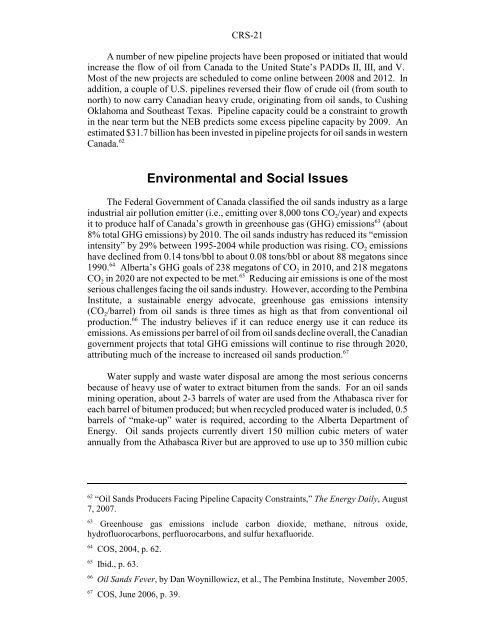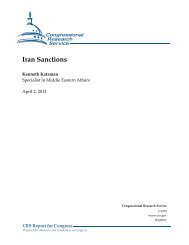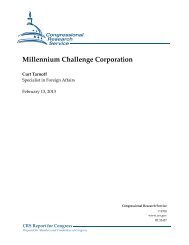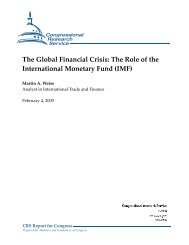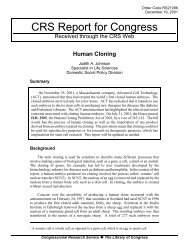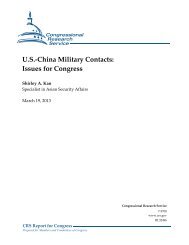North American Oil Sands: History of ... - The Air University
North American Oil Sands: History of ... - The Air University
North American Oil Sands: History of ... - The Air University
Create successful ePaper yourself
Turn your PDF publications into a flip-book with our unique Google optimized e-Paper software.
CRS-21<br />
A number <strong>of</strong> new pipeline projects have been proposed or initiated that would<br />
increase the flow <strong>of</strong> oil from Canada to the United State’s PADDs II, III, and V.<br />
Most <strong>of</strong> the new projects are scheduled to come online between 2008 and 2012. In<br />
addition, a couple <strong>of</strong> U.S. pipelines reversed their flow <strong>of</strong> crude oil (from south to<br />
north) to now carry Canadian heavy crude, originating from oil sands, to Cushing<br />
Oklahoma and Southeast Texas. Pipeline capacity could be a constraint to growth<br />
in the near term but the NEB predicts some excess pipeline capacity by 2009. An<br />
estimated $31.7 billion has been invested in pipeline projects for oil sands in western<br />
Canada. 62<br />
62 “<strong>Oil</strong> <strong>Sands</strong> Producers Facing Pipeline Capacity Constraints,” <strong>The</strong> Energy Daily, August<br />
7, 2007.<br />
63 Greenhouse gas emissions include carbon dioxide, methane, nitrous oxide,<br />
hydr<strong>of</strong>luorocarbons, perfluorocarbons, and sulfur hexafluoride.<br />
64 COS, 2004, p. 62.<br />
65 Ibid., p. 63.<br />
66 <strong>Oil</strong> <strong>Sands</strong> Fever, by Dan Woynillowicz, et al., <strong>The</strong> Pembina Institute, November 2005.<br />
67 COS, June 2006, p. 39.<br />
Environmental and Social Issues<br />
<strong>The</strong> Federal Government <strong>of</strong> Canada classified the oil sands industry as a large<br />
industrial air pollution emitter (i.e., emitting over 8,000 tons CO 2/year) and expects<br />
it to produce half <strong>of</strong> Canada’s growth in greenhouse gas (GHG) emissions 63 (about<br />
8% total GHG emissions) by 2010. <strong>The</strong> oil sands industry has reduced its “emission<br />
intensity” by 29% between 1995-2004 while production was rising. CO 2 emissions<br />
have declined from 0.14 tons/bbl to about 0.08 tons/bbl or about 88 megatons since<br />
1990. 64 Alberta’s GHG goals <strong>of</strong> 238 megatons <strong>of</strong> CO 2 in 2010, and 218 megatons<br />
CO 2 in 2020 are not expected to be met. 65 Reducing air emissions is one <strong>of</strong> the most<br />
serious challenges facing the oil sands industry. However, according to the Pembina<br />
Institute, a sustainable energy advocate, greenhouse gas emissions intensity<br />
(CO 2/barrel) from oil sands is three times as high as that from conventional oil<br />
production. 66 <strong>The</strong> industry believes if it can reduce energy use it can reduce its<br />
emissions. As emissions per barrel <strong>of</strong> oil from oil sands decline overall, the Canadian<br />
government projects that total GHG emissions will continue to rise through 2020,<br />
attributing much <strong>of</strong> the increase to increased oil sands production. 67<br />
Water supply and waste water disposal are among the most serious concerns<br />
because <strong>of</strong> heavy use <strong>of</strong> water to extract bitumen from the sands. For an oil sands<br />
mining operation, about 2-3 barrels <strong>of</strong> water are used from the Athabasca river for<br />
each barrel <strong>of</strong> bitumen produced; but when recycled produced water is included, 0.5<br />
barrels <strong>of</strong> “make-up” water is required, according to the Alberta Department <strong>of</strong><br />
Energy. <strong>Oil</strong> sands projects currently divert 150 million cubic meters <strong>of</strong> water<br />
annually from the Athabasca River but are approved to use up to 350 million cubic


